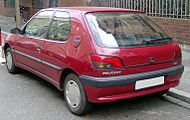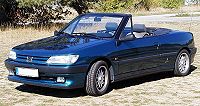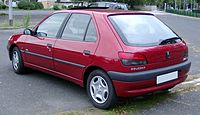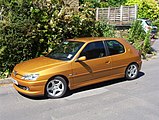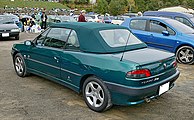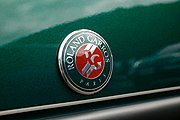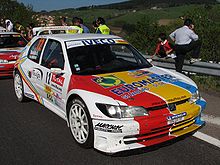Peugeot 306
| Peugeot | |
|---|---|
|
Peugeot 306 three-door (1993-1997)
|
|
| 306 | |
| Production period: | 1993-2002 |
| Class : | Compact class |
| Body versions : | Hatchback , sedan , station wagon , convertible |
| Engines: |
Otto engines : 1.1–2.0 liters (40–120 kW) Diesel engines : 1.8–2.0 liters (44–68 kW) |
| Length: | 3995-4232 mm |
| Width: | 1680-1683 mm |
| Height: | 1380-1386 mm |
| Wheelbase : | 2540-2580 mm |
| Empty weight : | 1020-1345 kg |
| Previous model | Peugeot 309 |
| successor | Peugeot 307 |
| Stars in the Euro NCAP - Crash Test |
|
The Peugeot 306 is a compact class car that was produced from the beginning of 1993 to mid-2001 (station wagon and convertible: until spring 2002).
history
The 306 was introduced in March 1993 with petrol engines from 40 to 89 kW (55 to 121 hp) and diesel engines from 44 to 68 kW (60 to 92 hp) and replaced the Peugeot 309 . During the nine-year construction period, different engine variants with up to 120 kW (163 hp) were available.
Initially, the body was only available with a hatchback with three or five doors. The two-door cabriolet with four seats was available from April 1994. The car has a fabric roof that can be completely retracted into a convertible top compartment and is protected by its own hood independently of the trunk lid. The trunk remains the same. Its lines were drawn by Pininfarina and manufactured in Italy . The roof was initially available with manual or electro-hydraulic actuation, depending on the model, the rear window on all models is not made of glass, but of plastic.
In October 1994 a four-door body with a notchback followed . In May 1997, one was under facelifts of a break called combi nachgeschoben.
The Citroën ZX , which is also part of the PSA Group, is based on the same platform as the 306 .
In Germany , the 306 was a competitor to the VW Golf III at the time (advertising slogan: “The rival”), but the model was not as successful in the German-speaking world as it was in France . A total of almost 3 million copies were built.
Technical specifications
Petrol engines
| 1.1i | 1.4i | 1.6i | 1.8i | 2.0i | 2.0i 16V (S16) | 2.0i 16V (GTi6) | |||
|---|---|---|---|---|---|---|---|---|---|
| Construction period | 01 / 1993-02 / 1997 | 05 / 1993-05 / 1994 | 06 / 1994-03 / 1996 | 03 / 1996-02 / 1997 | |||||
| Engine characteristics | |||||||||
| Engine identification |
TU1 M + / Z / L / L3 (HDY) |
TU1M + / Z / L / L3 (HDZ) |
TU3 M + / Z / C / L / L3 (KDX) |
TU5 JP / Z / L / L3 (commercial vehicle) |
XU7 JP / Z / L / L3 (LFZ) |
XU10 J2C / Z / L / L3 (RFX) |
XU10J4D / Z (RFY) |
XU10J4D / Z (RFT) |
XU10J4RS / Z / L3 (RFS) |
| Engine type | R4 petrol engine | ||||||||
| Number of valves per cylinder | 2 | 4th | |||||||
| Valve control | OHC , timing belt | DOHC, timing belt | |||||||
| Mixture preparation | Central injection | Manifold injection | |||||||
| Engine charging | - | ||||||||
| cooling | Water cooling | ||||||||
| Bore × stroke | 72.0 mm × 69.0 mm | 75.0 mm × 77.0 mm | 78.5 mm × 82.0 mm | 83.0 mm × 81.4 mm | 86.0 mm × 86.0 mm | ||||
| Displacement | 1124 cc | 1360 cc | 1587 cc | 1762 cc | 1998 cc | ||||
| Compression ratio | 9.4: 1 | 9.3: 1 | 9.6: 1 | 9.25: 1 | 9.5: 1 | 10.4: 1 | 10.8: 1 | ||
| Max. Power at min −1 | 40 kW (55 PS) / 6200 |
44 kW (60 PS) / 6200 |
55 kW (75 PS) / 5800 |
65 kW (88 PS) / 5600 |
74 kW (101 PS) / 6000 |
89 kW (121 PS) / 5750 |
112 kW (152 PS) / 6500 |
110 kW (150 PS) / 6500 |
120 kW (163 hp) / 6500 |
| Max. Torque in min -1 | 88 Nm / 3800 |
111 Nm / 3400 |
135 Nm / 3000 |
153 Nm / 3000 |
176 Nm / 2750 |
183 Nm / 3500 |
193 Nm / 5500 |
||
| Power transmission | |||||||||
| drive | Front wheel drive | ||||||||
| Gearbox, as standard | 5-speed manual transmission | 6-speed manual transmission |
|||||||
| Gearbox, optional | - | 4- speed automatic transmission | - | ||||||
| Measured values 1 | |||||||||
| Top speed | k. A. | 155 km / h | 165 km / h | 179 km / h (174 km / h) |
185 km / h (175 km / h) |
197 km / h (193 km / h) |
215 km / h | 220 km / h | |
| Acceleration, 0-100 km / h | k. A. | 18.4 s | 14.9 s | 13.5 s (14.1 s) |
12.3 s (13.6 s) |
10.4 s (12.7 s) |
9.2 s | 8.8 s | |
| Fuel consumption over 100 km (combined) | k. A. | 6.9 l p | 6.8 l S | 7.7 l S (7.8 l S) |
7.0 l S (7.6 l S) |
7.5 l S (7.7 l S) |
7.8 l S | 9.4 l S | |
Diesel engines
| 1.8 D | 1.9 D | 1.9 DT | |||
|---|---|---|---|---|---|
| Construction period | 05 / 1993-02 / 1997 | 06 / 1994-02 / 1997 | |||
| Engine characteristics | |||||
| Engine identification |
XUD7 / L (A9A) |
XUD9 A / K / L (D9B) |
XUD9A / Y / L3 (DJY) |
XUD9TE / L (D8A) |
XUD9TE / Y / L3 (DHY) |
| Engine type | R4 diesel engine | ||||
| Number of valves per cylinder | 2 | ||||
| Valve control | OHC , timing belt | ||||
| Mixture preparation | Swirl chamber injection | ||||
| Engine charging | - |
Turbocharger , intercooler |
|||
| cooling | Water cooling | ||||
| Bore × stroke | 80.0 mm × 88.0 mm | 83.0 mm × 88.0 mm | |||
| Displacement | 1769 cc | 1905 cc | |||
| Compression ratio | 23.0: 1 | 21.8: 1 | |||
| Max. Power at min −1 | 44 kW (60 PS) / 4600 |
51 kW (69 PS) / 4600 |
50 kW (68 PS) / 4600 |
68 kW (92 PS) / 4000 |
66 kW (90 PS) / 4000 |
| Max. Torque in min -1 | 110 Nm / 2000 |
120 Nm / 2000 |
196 Nm / 2250 |
||
| Power transmission | |||||
| drive | Front wheel drive | ||||
| transmission | 5-speed manual transmission | ||||
| Readings | |||||
| Top speed | k. A. | 162 km / h | 180 km / h | ||
| Acceleration, 0-100 km / h | k. A. | 16.9 s | 12.4 s | ||
| Fuel consumption over 100 km (combined) | 6.1 l D | 6.3 l D | 6.5 l D | 6.2 l D | 6.6 l D |
Facelift
In May 1997, a revision was carried out on the 306 (PSA internal "restyle"), with retouching mainly carried out in the area of the bumpers (round fog lights etc.) and in the interior (among other things, the immobilizer placed on the numeric keypad in the area of the center console was deleted ).
As of June 1999, the Peugeot 306 was (the convertible excluded) with Common Rail - Turbo Diesel ordered (HDI), which motor (90 hp) at around two liters capacity 66 kW. Also in 1999 the equipment with side airbags flowed into the current production . Special models with higher equipment compared to the standard versions (XN, XS, XR / XT, XSi, S16) were available with the names Roland Garros , St. Tropez or Platinum for the convertible version. All model variants have now been equipped with an electro-hydraulic convertible top as standard.
The most powerful model variant of the 306 was the S16 , which in the second edition (from June 1996) developed 120 kW (163 hp) and delivered a torque of up to 193 Nm. A standard manifold and a new type of intake pipe made it possible to increase the performance by 13 hp compared to the previous model. The six-speed gearbox was atypical for cars in this size category at the time . The GTI-6 also had a kinematically steered rear axle, as was also used in the Citroën ZX , later in the Citroën Xantia and the Xsara . It improves stability at high cornering speeds. In the GTI-6, it contributed to a stronger load change reaction (increased oversteer when the accelerator was suddenly released in curves), which made the GTI-6 very active and agile for a front-wheel drive vehicle compared to the competition on racetracks or winding roads such as mountain passes Made compact cars very sporty and fast.
In June 2001 the production of the hatchback and notchback sedans of the 306 was ended, whereas station wagons and convertibles rolled off the production line until April 2002. The 307 was introduced as a successor in October 2001 .
Technical specifications
Petrol engines
| 1.4i | 1.6i | 1.8i | 1.8i 16V | 2.0i 16V (XS) | 2.0i 16V (GTi6) | |||
|---|---|---|---|---|---|---|---|---|
| Construction period | 03 / 1997-10 / 2000 | 10 / 2000-04 / 2002 | 03 / 1997-10 / 2000 | 10 / 2000-04 / 2002 | 03 / 1997-05 / 1999 | 03 / 1997-04 / 2002 | 03 / 1997-10 / 2000 | |
| Engine characteristics | ||||||||
| Engine identification |
TU3 JP / Z / L / L3 / W2 (KFX) |
TU3JP (KFW) |
TU5 JP / Z / L / L3 (commercial vehicle) |
TU5JP / L4 (NFT) |
XU7 JP / Z / L / L3 (LFZ) |
XU7JP4 (LFY) |
XU10 J4R (RFV) |
XU10J4RS / Z / L3 (RFS) |
| Engine type | R4 petrol engine | |||||||
| Number of valves per cylinder | 2 | 2 | 4th | |||||
| Valve control | OHC , timing belt | OHC, timing belt | DOHC, timing belt | |||||
| Mixture preparation | Manifold injection | |||||||
| Engine charging | - | |||||||
| cooling | Water cooling | |||||||
| Bore × stroke | 75.0 mm × 77.0 mm | 78.5 mm × 82.0 mm | 83.0 mm × 81.4 mm | 86.0 mm × 86.0 mm | ||||
| Displacement | 1360 cc | 1587 cc | 1761 cc | 1998 cc | ||||
| Compression ratio | 10.2: 1 | 9.6: 1 | 10.5: 1 | 9.25: 1 | 10.4: 1 | 10.8: 1 | ||
| Max. Power at min −1 | 55 kW (75 PS) / 5500 |
65 kW (88 PS) / 5600 |
72.6 kW (98 PS) / 5700 |
74 kW (101 PS) / 6000 |
81 kW (110 PS) / 5500 |
97 kW (132 PS) / 5500 |
120 kW (163 hp) / 6500 |
|
| Max. Torque in min -1 | 111 Nm / 3400 |
120 Nm / 3400 |
135 Nm / 3000 |
137.8 Nm / 3250 |
153 Nm / 3000 |
155 Nm / 4250 |
180 Nm / 4200 |
193 Nm / 5500 |
| Power transmission | ||||||||
| drive | Front wheel drive | |||||||
| Gearbox, as standard | 5-speed manual transmission | 4-stage automatic transmission |
5-speed manual transmission |
6-speed manual transmission |
||||
| Gearbox, optional | - | 4-stage automatic transmission |
- | 4-stage automatic transmission |
- | |||
| Measured values 1 | ||||||||
| Top speed | 170 km / h | 179 km / h (174 km / h) |
183 km / h | (175 km / h) | 192 km / h | 201 km / h | 220 km / h | |
| Acceleration, 0-100 km / h | 14.7 s | 13.5 s (14.1 s) |
k. A. | (13.6 s) | 11.2 s | 10.4 s | 8.8 s | |
| Fuel consumption over 100 km (combined) | 6.9 l p | 6.6 l p | 7.7 l S (7.8 l S) |
6.9 l S (7.8 l S) |
(7.6 l S) | 8.1 l p | 9.1 L S (9.2 L S) |
9.4 l S |
Diesel engines
| 1.8 D | 1.9 D | 1.9 SD | 1.9 TD | 2.0 HDi | |||
|---|---|---|---|---|---|---|---|
| Construction period | 03 / 1997-05 / 1999 | 06 / 1999-10 / 2000 | 10 / 2000-04 / 2002 | 03 / 1997-09 / 1998 | 03 / 1997-05 / 1999 | 06 / 1999-04 / 2002 | |
| Engine characteristics | |||||||
| Engine identification |
XUD7 / L (A9A) |
XUD9 A / Y / L3 (DJY) |
DW8 (WJZ) |
DW8 (WJY) |
XUD9BSD (DHV) |
XUD9TE / Y / L3 (DHY) |
DW10 TD (RHY) |
| Engine type | R4 diesel engine | ||||||
| Number of valves per cylinder | 2 | ||||||
| Valve control | OHC , timing belt | ||||||
| Mixture preparation | Swirl chamber injection |
Common rail injection |
|||||
| Engine charging | - | turbocharger | Turbocharger, intercooler |
turbocharger | |||
| cooling | Water cooling | ||||||
| Bore × stroke | 80.0 mm × 88.0 mm | 83.0 mm × 88.0 mm | 82.2 mm x 88.0 mm | 83.0 mm × 88.0 mm | 85.0 mm × 88.0 mm | ||
| Displacement | 1769 cc | 1905 cc | 1868 cc | 1905 cc | 1997 cc | ||
| Compression ratio | 23.0: 1 | 21.8: 1 | 18.0: 1 | ||||
| Max. Power at min −1 | 44 kW (60 PS) / 4600 |
50 kW (68 PS) / 4600 |
51 kW (69 PS) / 4600 |
55 kW (75 PS) / 4600 |
66 kW (90 PS) / 4000 |
||
| Max. Torque in min -1 | 110 Nm / 2000 |
120 Nm / 2000 |
125 Nm / 2500 |
135 Nm / 2250 |
196 Nm / 2250 |
205 Nm / 1900 |
|
| Power transmission | |||||||
| drive | Front wheel drive | ||||||
| transmission | 5-speed manual transmission | ||||||
| Readings | |||||||
| Top speed | k. A. | 162 km / h | 161 km / h | k. A. | 180 km / h | ||
| Acceleration, 0-100 km / h | k. A. | 16.9 s | k. A. | 12.4 s | 12.6 s | ||
| Fuel consumption over 100 km (combined) | 6.1 l D | 6.5 l D | 6.2 l D | 6.3 l D | k. A. | 6.6 l D | 5.3 l D |
Motorsport
The Peugeot 306 was also used successfully in rallying .
- 2.0i 16V MAXI EVO 1 - 205 kW (280 PS) at 8700 rpm; First use in motorsport: Rally Alsace-Vogues 1995
- 2.0i 16V MAXI EVO 2 - 217 kW (308 hp) at 11,000 rpm; first use in motorsport: Catalunya 1997
(Both racing engines are based on the XU10J4RS engine)
literature
- Automobile revue. Catalog 1995, 2000 and 2001.
Individual evidence
- ↑ Peugeot 306. www.euroncap.com, accessed July 16, 2018 .
Web links
| Timeline of the Peugeot models since 1945 | ||||||||||||||||||||||||||||||||||||||||||||||||||||||||||||||||||||||||||||
|---|---|---|---|---|---|---|---|---|---|---|---|---|---|---|---|---|---|---|---|---|---|---|---|---|---|---|---|---|---|---|---|---|---|---|---|---|---|---|---|---|---|---|---|---|---|---|---|---|---|---|---|---|---|---|---|---|---|---|---|---|---|---|---|---|---|---|---|---|---|---|---|---|---|---|---|---|
| Type | 40s | 50s | 60s | 70s | 80s | 90s | 2000s | 2010s | 2020s | |||||||||||||||||||||||||||||||||||||||||||||||||||||||||||||||||||
| 5 | 6th | 7th | 8th | 9 | 0 | 1 | 2 | 3 | 4th | 5 | 6th | 7th | 8th | 9 | 0 | 1 | 2 | 3 | 4th | 5 | 6th | 7th | 8th | 9 | 0 | 1 | 2 | 3 | 4th | 5 | 6th | 7th | 8th | 9 | 0 | 1 | 2 | 3 | 4th | 5 | 6th | 7th | 8th | 9 | 0 | 1 | 2 | 3 | 4th | 5 | 6th | 7th | 8th | 9 | 0 | 1 | 2 | 3 | 4th | 5 | 6th | 7th | 8th | 9 | 0 | 1 | 2 | 3 | 4th | 5 | 6th | 7th | 8th | 9 | 0 | |
| Microcar | ion | |||||||||||||||||||||||||||||||||||||||||||||||||||||||||||||||||||||||||||
| 106 | 107 | 108 | ||||||||||||||||||||||||||||||||||||||||||||||||||||||||||||||||||||||||||
| Small car | 104 | 205 | 206 | |||||||||||||||||||||||||||||||||||||||||||||||||||||||||||||||||||||||||
| 202 | 207 | 208 I. | 208 II | |||||||||||||||||||||||||||||||||||||||||||||||||||||||||||||||||||||||||
| Compact class | 204 | 301 | ||||||||||||||||||||||||||||||||||||||||||||||||||||||||||||||||||||||||||
| 203 | 304 | 305 | 306 | 307 | 308 I. | 308 II | ||||||||||||||||||||||||||||||||||||||||||||||||||||||||||||||||||||||
| Lower middle class | 309 | 408 I. | 408 II | |||||||||||||||||||||||||||||||||||||||||||||||||||||||||||||||||||||||||
| Middle class | 403 | 404 | 405 | 406 | 407 | |||||||||||||||||||||||||||||||||||||||||||||||||||||||||||||||||||||||
| 505 | 508 I. | 508 II | ||||||||||||||||||||||||||||||||||||||||||||||||||||||||||||||||||||||||||
| upper middle class | 504 | |||||||||||||||||||||||||||||||||||||||||||||||||||||||||||||||||||||||||||
| 604 | 605 | 607 | ||||||||||||||||||||||||||||||||||||||||||||||||||||||||||||||||||||||||||
| Coupe | RCZ | |||||||||||||||||||||||||||||||||||||||||||||||||||||||||||||||||||||||||||
| 404 coupe | 504 coupe | 406 coupe | 407 coupe | |||||||||||||||||||||||||||||||||||||||||||||||||||||||||||||||||||||||||
| Minivan | 1007 | |||||||||||||||||||||||||||||||||||||||||||||||||||||||||||||||||||||||||||
| Crossover | 2008 I. | 2008 II | ||||||||||||||||||||||||||||||||||||||||||||||||||||||||||||||||||||||||||
| 3008 I. | ||||||||||||||||||||||||||||||||||||||||||||||||||||||||||||||||||||||||||||
| SUV | 3008 II | |||||||||||||||||||||||||||||||||||||||||||||||||||||||||||||||||||||||||||
| 4008 | ||||||||||||||||||||||||||||||||||||||||||||||||||||||||||||||||||||||||||||
| 4007 | ||||||||||||||||||||||||||||||||||||||||||||||||||||||||||||||||||||||||||||
| 5008 II | ||||||||||||||||||||||||||||||||||||||||||||||||||||||||||||||||||||||||||||
| Compact van | 5008 I. | |||||||||||||||||||||||||||||||||||||||||||||||||||||||||||||||||||||||||||
| Van | 806 | 807 | ||||||||||||||||||||||||||||||||||||||||||||||||||||||||||||||||||||||||||
| Off-road vehicle | P4 | |||||||||||||||||||||||||||||||||||||||||||||||||||||||||||||||||||||||||||
| Pick up | 403 truck | 404 pick up | 504 pick up | Pick up | Land trek | |||||||||||||||||||||||||||||||||||||||||||||||||||||||||||||||||||||||
| High roof combination | Traveler | |||||||||||||||||||||||||||||||||||||||||||||||||||||||||||||||||||||||||||
| Box van | 205 Multi / Fourgonnette | |||||||||||||||||||||||||||||||||||||||||||||||||||||||||||||||||||||||||||
| Bipper | ||||||||||||||||||||||||||||||||||||||||||||||||||||||||||||||||||||||||||||
| partner | partner | Rifter | ||||||||||||||||||||||||||||||||||||||||||||||||||||||||||||||||||||||||||
| Transporter | D3 | D4 | J7 | J9 | Expert | Expert | Expert | |||||||||||||||||||||||||||||||||||||||||||||||||||||||||||||||||||||
| J5 | boxer | boxer | ||||||||||||||||||||||||||||||||||||||||||||||||||||||||||||||||||||||||||
|
|
||||||||||||||||||||||||||||||||||||||||||||||||||||||||||||||||||||||||||||
| Timeline of the Peugeot models from 1889 to 1944 | ||||||||||||||||||||||||||||||||||||||||||||||||||||||||
|---|---|---|---|---|---|---|---|---|---|---|---|---|---|---|---|---|---|---|---|---|---|---|---|---|---|---|---|---|---|---|---|---|---|---|---|---|---|---|---|---|---|---|---|---|---|---|---|---|---|---|---|---|---|---|---|---|
| Type | 1880s | 1890s | 1900s | 1910s | 1920s | 1930s | 1940s | |||||||||||||||||||||||||||||||||||||||||||||||||
| 9 | 0 | 1 | 2 | 3 | 4th | 5 | 6th | 7th | 8th | 9 | 0 | 1 | 2 | 3 | 4th | 5 | 6th | 7th | 8th | 9 | 0 | 1 | 2 | 3 | 4th | 5 | 6th | 7th | 8th | 9 | 0 | 1 | 2 | 3 | 4th | 5 | 6th | 7th | 8th | 9 | 0 | 1 | 2 | 3 | 4th | 5 | 6th | 7th | 8th | 9 | 0 | 1 | 2 | 3 | 4th | |
| Small car | 1 | 2 | 3 / 4 | 5 / 6 / 7 / 8 | 21 / 24 / 30 / 31 | 37 | 54 | 57 | 69 "Bébé" | B P1 / B3 / P1 "Bébé" [1] | 161/172 "Quadrilette" | 190 | ||||||||||||||||||||||||||||||||||||||||||||
| 26 / 27 / 28 | 48 | 126 | 201 | 202 ... | ||||||||||||||||||||||||||||||||||||||||||||||||||||
| Compact class | 14 / 15 / 25 | 56 | 58 | 68 | VA / VC / VY [1] | V2C / V2Y [1] | VD / VD2 [1] | 159 | 163/163 BS | 301 | 302 | |||||||||||||||||||||||||||||||||||||||||||||
| 33 / 36 | 63 | 99 | 108 | 118 | 125 | 173 / 177 / 181 / 183 | ||||||||||||||||||||||||||||||||||||||||||||||||||
| Middle class | 9 / 10 / 11 / 12 | 16 / 17 / 19 / 32 | 49/50 | 65/67 | 77 | 78 | 88 | 127 | 143 | 153 | 153 B / BR | 176 | 401 | 402 | ||||||||||||||||||||||||||||||||||||||||||
| 18th | 39 | 61 | 71 | 81 | 96 | 106 | 116 | 126 | 138 | 175 | ||||||||||||||||||||||||||||||||||||||||||||||
| upper middle class | 23 | 42/43/44 | 62 | 72 | 82 | 92 | 104 | 112/117/122/130/134 | 139 | 145/146/148 | 174 / 184 | 601 | ||||||||||||||||||||||||||||||||||||||||||||
| 66 | 76 | 83 | 93 | 135 | 156 | |||||||||||||||||||||||||||||||||||||||||||||||||||
| Upper class | 80 | 103 | 113 | 141 | 147/150 | |||||||||||||||||||||||||||||||||||||||||||||||||||
| 85 | 95 | 105 | ||||||||||||||||||||||||||||||||||||||||||||||||||||||
| Convertible / Spider | 91 | 101/120 | 133 / 111/129/131 | 136 | 144 | |||||||||||||||||||||||||||||||||||||||||||||||||||
| Box van | 13 | 22nd | 34/35 | |||||||||||||||||||||||||||||||||||||||||||||||||||||
| minibus | 20 / 29 | 107 | ||||||||||||||||||||||||||||||||||||||||||||||||||||||

